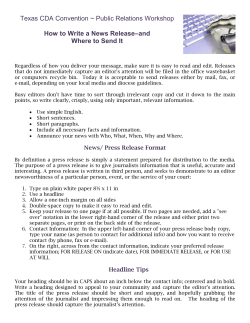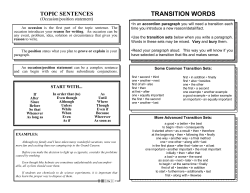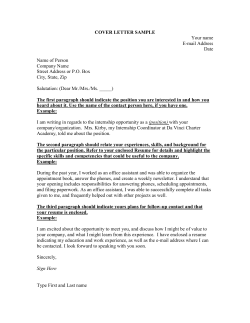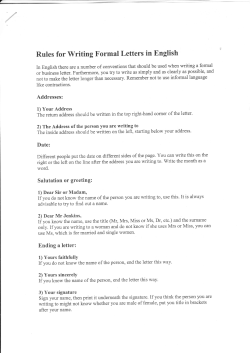
Document 290107
This is the second set of lessons designed around the QCA sample material for the new KS3 test. This short, 4-lesson (4 hour) unit centres on the short writing task element. We are again indebted to Ann Fewson and her department from St Aidan’s Church of England Technology College for permission to share their work with you. Resources You will need: Sample material for Macbeth from the CGP sample papers. www.cgpbooks.co.uk Sample materials and mark scheme from QCA available on www.qca.org Page 18 Reading Journal principles from the Transition Unit Booklet Ref: 0113/2002 available on website www.standards.dfes.gov.uk Posters to define Audience, Purpose and Form and the NC triplets. Use Framework for Teaching English Modelled answer for the CGP question. Booster page 157 for pairs to complete Blank Booster box template (to be made in-house) Level 5 Criteria Lesson 3 q q q q Topic sentence Supporting detail Persuasive vocabulary Rhetorical devices. This list will change depending upon your curricular/class targets. The longer list includes: q Paragraphing q Appropriate connectives e.g. verb phrases q Modal verbs and conditional clauses q Attention to accurate punctuation q Consistency of style and tone q Clear sense of audience and purpose q Use of complex regular spellings. Refer closely to the sample mark scheme for detail. Some suggested activities Use card sorts for the starters. Sort connectives, sort examples of persuasive connectives or rhetorical devices. Have students define audience, purpose and form for the posters and define the triplets, if time, could be extension activity for higher ability. For coding content of paragraphs you can divide your board into three; you could record all elements and then further code by colour ringing where students feel the statement ought to go; student recording into reading journal and highlighting in different colours (or underline in coloured pencil/crayon if highlighters are problematic). Introduction Give Macbeth question and blank Booster box from p 157. In pairs fill in information. Have class poster/A5 size for RJ ready describing audience purpose and form. Use page 157 from Booster pack. Complete in pairs. Draw attention to the bullet points. Explain that, as adult writers, you would assume three paragraphs. Emphasise the precise nature and explain answer limited to 1 side A4. Brainstorm all the elements the students think could be included in the text. Use various ways (see Teaching Notes) to categorise. Explain the context of the next 3 lessons and give the QCA Macbeth sample question.. Allow 30 minutes. Have modelled answer ready to share with class. Use mark scheme form CGP pack to inform answer. Aim at Level 5 but with higher achieving classes indicate where more complex writing skills will achieve 6 and 7. Students complete under exam conditions CGP Macbeth question ‘Go on---you can do it’ Word/sentence activity Request some students to identify/explain where they had included level 5 content into their own answers. Plenary Explain task and set H/W. In pairs to write 1st paragraph in no more than 100 words. (You might limit this to 50 with high achievers). Paragraph must include L5 criteria from mark scheme (see teaching notes) 2nd paragraph is H/W in RJ. ‘Why it will appeal to young people’ Previously selected students to read out writing and explain where they have used 1 or 2 criteria. Students annotate in pairs for A,P and F and for uncertainties in their own knowledge. Take feedback, list common uncertainties making sure that publicity, educational benefits, and, in particular, outlining are covered. Lead discussion on these to arrive at common definitions and understanding. Lead discussion on clues to text type and the concise and precise nature of the task (indicated by outlining) Back to starter, explain triplets using poster/OHT. Have class resource and stick into RJ Share read modelled answer. Use OHT or photocopied sheet for class to model annotations. Stick into reading journal. Use as revision instrument. Deal with improvements suggested by students if appropriate by editing work. Development Objectives Objectives W8, S1, 3, 5, Wr. 1, 2, 3, 13 S and L 2 and R 3. Major Teaching Emphases are to make students aware of the context of the assessment; to help them to understand the precise/concise requirements of the written task; to understand and focus on sentence level objectives. Framework for teaching English: Years 7, 8 and 9 Lesson 3 Lesson 2 Lesson 1 Year: 9 Term: 2 Week: Teacher: Short-term Plan Independent writing of 2nd paragraph. Limit 100 words Homework Accessing the new KS3 test format and tasks. School Priorities Round class for persuasive connectives or rhetorical devices in various ways. (See teaching notes) Word/sentence activity Having looked through H/W; have 2/3 students work on OHT or photocopied sheet.. share read and critically review work against criteria. Offer improvements. Teacher to annotate. Introduction This is also an excellent opportunity for a guided writing session with a group focused from your preliminary reading Independently write final paragraph. Allow 10 minutes only. This will be assessed formally as marked piece by teacher. In pairs, with response partner, review each others’ texts and suggest 1 or two improvements. Development 1 or 2 students to read out work and explain where they have made an improvement against the criteria in paragraph 2. Plenary Objectives W8, S1, 3, 5, Wr. 1, 2, 3, 13 S and L 2 and R 3. Major Teaching Emphases are to make students aware of the context of the assessment; to help them to understand the precise/concise requirements of the written task; to understand and focus on sentence level objectives. Framework for teaching English: Years 7, 8 and 9 Lesson Lesson Lesson 4 Year: 9 Term: 2 Week: Teacher: Short-term Plan Homework Accessing the new KS3 test format and tasks. School Priorities
© Copyright 2025





















